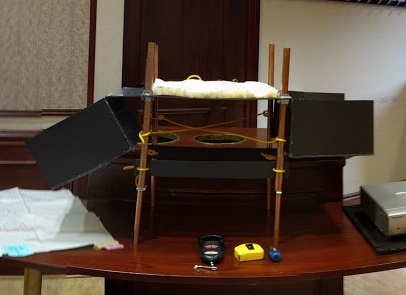Designing a Portable Projector Enclosure for IT Services
Time frame: November-December, 2016
Project type: Team
My responsibilities: Research, stakeholder engagement, idea exploration, prototype building
After noticing the trouble some teaching staff had to go through to setup a projector in a room that did not have one built in, my team initially considered working with the Engineering Science office, and their distribution of portable projectors. However, after talking with them and doing some further research, we decided that our efforts could be better spent working instead with Academic and Campus Events, whose IT department provides portable projectors (amongst other equipment) for most of the U of T St. George campus. We learned that their existing process involved wheeling a large projector around on a plastic or metal cart between their storage locations and the classrooms, regardless of conditions outside or accessibility of the building. Our goal was to improve the ease of transportation and setup for the IT workers responsible for managing the projectors.
Once we had finished our initial analysis of the problem (see my design process), we began the phase of creativity and exploration. We started by breaking out and individually coming up with as many potential ideas as we could, with the hope of combining promising elements later on. Throughout this process, we often cycled back to Phase I to redefine our objectives as our understanding of the opportunity adapted, in part from interacting with more stakeholders. This was one of the first places I learned the importance of having a cyclical aspect to a design process, as there is never perfect understanding right at the beginning. Cycling back and forth allowed us to better understand the situation, and thus generate more appropriate ideas.
We used a number of formal converging and diverging tools to help formalize our design activities, and ensure that we were being as rigorous and complete as possible throughout the project.

Once example of an idea generation session, using the SCAMPER technique.
After generating possible solutions and diverging down to key elements we thought would be most effective, we began the process of early prototyping. A key detail about prototypes is that they are made to give you some new piece of information. In our case, we wanted to get a better feel for how our ideas would actually look life-sized, and if some of our components (such as folding doors) would actually work. We would have liked to have made a higher fidelity prototype with better materials, but were unfortunately limited in time, budget, and technical ability.

Our final prototype. Unfortunately, due to only having low-quality materials available to us, the prototype was very bulky and unstable. However, it did serve its purpose of allowing us to visualize how it would work and verifying that our design choices (telescoping legs and folding panels) were feasible.
Finally, we finished the project with an opportunity to defend our findings and design. The first was the Alpha presentation, which was our first major design presentation to our teaching team. We learned the importance of having any and all evidence quickly available to justify the claims we were making, and the necessity of rehearsing and following a structure for a presentation with a time limit. Our findings were also written up into a recommendation report, where we detailed our design and justified why it would be an improvement over the existing technology.
Lessons Learned
This was our first big project that necessitated having a working relationship with a community, and we learned early on the importance of having thorough stakeholder interaction and understanding. Initially, our claims were being made more skeptically, and as such were much less appropriate. However, after visiting and talking with a number of potentially affected people and doing some extra research, we were able to develop a much more credible set of requirements. This ultimately informed the first Phase of my design process, where I indicate the importance of working with stakholders and developing an understanding of the design space in a cyclical manner.